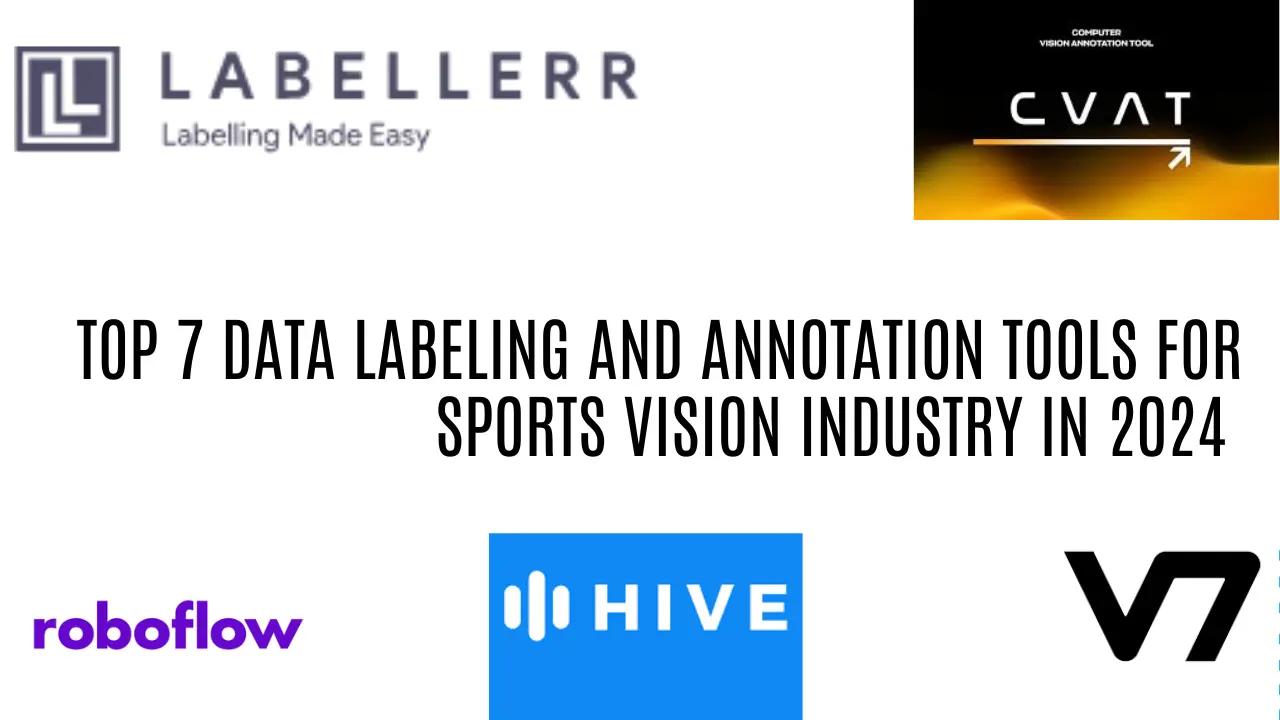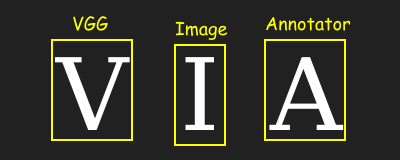7 Best Data Labeling and Annotation Tools For Sports Vision Industry

In the fast-paced and highly competitive sports industry, the integration of advanced technology has become pivotal in gaining a competitive edge. One of the most transformative technologies in this realm is computer vision, which leverages artificial intelligence (AI) to analyze and interpret visual data.
At the heart of effective computer vision systems lies the critical process of data labeling and annotation.
Accurate and comprehensive data annotation is essential for training robust AI models that can recognize, track, and interpret various elements within sports footage, from player movements to ball trajectories and even crowd dynamics.
The sports vision industry encompasses a broad spectrum of applications, including performance analysis, injury prevention, game strategy development, and fan engagement.
High-quality labeled data enables these applications by ensuring that AI models can accurately identify and analyze relevant patterns and events in real-time or recorded footage.
However, the process of labeling and annotating sports data is particularly challenging due to the dynamic and complex nature of sports environments, where multiple objects and actions often overlap and occur at high speed.
In this blog, we will explore some of the top data labeling and annotation tools tailored for the sports vision industry. We will examine their key features, benefits, and use cases, providing insights into how they can be employed to elevate the performance and accuracy of sports-related AI applications.
Table Of Contents
- Key Applications of Data Annotation and Labeling in the Sports Vision Industry
- Labellerr
- Encord
- V7 Labs
- Hive
- Roboflow
- VGG Image Annotator (VIA)
- CVAT (Computer Vision Annotation Tool)
- Conclusion
- FAQS:
Key Applications of Data Annotation and Labeling in the Sports Vision Industry
Performance Analysis
Technique Refinement: By annotating specific movements and actions, coaches can analyze the biomechanics of athletes, leading to refined techniques and improved efficiency in movements.
Progress Tracking: Annotated data over time helps track an athlete's progress, highlighting improvements or regressions in performance, and allowing for data-driven adjustments to training regimens.
Comparative Analysis: Athletes can be compared against benchmarks or elite performers in their field, using annotated data to highlight areas where they excel or need improvement.
Psychological Insights: Analyzing behavior and body language through annotated video can provide insights into an athlete's psychological state, aiding in mental conditioning strategies.
Player Monitoring
Movement Pattern Analysis: Labeling data related to joint angles, force application, and movement patterns helps in identifying risky behaviors that could lead to injuries.
Recovery Monitoring: Post-injury, annotated data can be used to monitor an athlete’s recovery process, ensuring they return to optimal performance levels safely.
Load Management: Annotated data helps in understanding the impact of workload and intensity, allowing for better management to prevent overtraining and related injuries.
Customized Training Programs: Data-driven insights from annotations enable the creation of personalized training programs that mitigate specific injury risks for individual athletes.
Game Strategy Development
Tactical Insights: Detailed annotation of various play phases helps in understanding and developing effective tactical plans tailored to counter opponents’ strategies.
Player Positioning: Analyzing annotated data on player positioning and movement patterns provides insights into optimal formations and spatial arrangements.
Play Prediction: AI models trained on annotated game data can predict opponents' next moves, giving teams a strategic advantage during matches.
Scenario Planning: Annotated data allows coaches to simulate various game scenarios and devise strategies to handle different situations effectively.
Referee Assistance and Officiating
Automated Decision Support: Annotated video data enhances the accuracy of automated systems in detecting fouls, offsides, and other critical events, supporting human referees in making precise decisions.
Video Assistant Referee (VAR) Systems: Detailed event annotations improve the efficiency and accuracy of VAR systems, ensuring fair and just officiating during matches.
Consistency in Officiating: By training AI systems on annotated data, the consistency and objectivity of refereeing decisions can be improved, reducing human error and bias.
Post-Match Analysis: Annotated data provides a basis for post-match reviews and analysis, helping referees and officials to learn and improve their decision-making processes.
Digital Advertisement in Sports
Digital advertisement within sports arenas, such as on screens and boundary fields, has become a crucial element of modern sports marketing. Utilizing data annotation and labeling tools, these advertisements can be made more dynamic and targeted, enhancing viewer engagement and sponsor value.
Targeted Ad Placement: AI models can analyze viewer demographics and behavior to place ads that are most relevant to the audience, increasing the effectiveness of the advertisements.
Real-Time Ad Adjustments: Annotated data allows for real-time adjustments to digital ads based on the flow of the game or crowd reactions, optimizing ad impact.
Enhanced Viewer Engagement: Interactive and augmented reality ads can be developed using annotated data to engage fans more deeply during the game.
Performance Analytics: Detailed labeling and tracking of ad performance provide insights into viewer interactions and ROI, helping refine future advertising strategies.
Top Data Annotation and Labeling Tools for the Sports Vision Industry
In the sports vision industry, precise and efficient data annotation tools are essential for developing robust AI models. Here are some of the top tools that are widely used for their advanced features and reliability:
1) Labellerr

Labellerr stands out as a powerful tool for data labeling and annotation tasks in the sports industry. Here's a breakdown of its key features, user reviews, and pricing:
Pros:
Feature-rich Segmentation: Perform faster segmentation with pixel perfection. Drag polygon and auto-bordering features prevent overlapping adjacent objects.
Auto-labeling: Accelerate use cases with semantic segmentation using features like SAM and active learning.
Professional Annotation Team: Handle large data volumes with fast turnaround times.
Custom SLA: Starting from 24 hours for batch completion.
24/7 Tool Support: Available for the Enterprise Plan.
Robust QA Process: Set up QA processes that include agreement between annotators, comparison based on ground truth and IOU metrics, model-assisted QA, generative AI-powered QA, and sample visual quality assurance.
Dedicated Account Manager: Manage daily/weekly output efficiently.
Data Privacy and Security Compliance: Comply with HIPAA and GDPR regulations.
Multi-tier Pricing: options based on quality measurement. The default QC process includes 1 round of annotation and 1 round of QC, customizable to match the expected output, timeline, and budget.
Cons:
Limited Format Support: This does not currently support point cloud and 3D data formats.
Pricing:
Pro Plan: Starts at $499 per month for 10-user access with 50,000 data credits included. Additional data credits can be purchased at $0.01 USD per data credit, and extra users can be subscribed to at $29 USD per user.
Enterprise Plan: Offers professional services, including tool customization and ML consultancy apart from custom data, workspace, and other limitations.
2) Encord

Encord is a versatile data annotation platform designed to streamline the process of labeling complex visual data. It is particularly well-suited for sports vision applications due to its comprehensive toolset and user-friendly interface.
Automated Labeling: Utilizes machine learning algorithms to automate the labeling process, significantly reducing manual effort and time.
Collaboration Features: Supports real-time collaboration among annotators, enabling efficient teamwork and consistent data quality.
Customizable Annotation Tools: Offers a range of customizable annotation tools to cater to specific needs, including bounding boxes, polygons, and key points.
Analytics and Quality Control: Provides detailed analytics and quality control metrics to ensure the accuracy and reliability of annotated data.
3) V7 Labs

V7 Labs offers an AI-powered platform for data annotation, known for its high level of automation and intuitive design. It is particularly effective for annotating complex sports scenarios.
Automated Segmentation: Features AI-driven automated segmentation to quickly label objects and actions, enhancing efficiency.
Flexible Workflow Management: Allows users to create and manage flexible workflows tailored to their specific annotation projects.
Real-time Collaboration: Facilitates real-time collaboration among team members, improving productivity and data consistency.
Advanced Annotation Types: Supports a wide variety of annotation types, including 2D and 3D bounding boxes, key points, and full-scene annotations.
4) Hive

Hive is a powerful data labeling platform that offers a suite of tools tailored for high-volume annotation tasks. It is ideal for sports vision projects requiring large-scale, accurate data labeling.
Scalable Annotation Solutions: Designed to handle large-scale annotation projects, making it suitable for extensive sports data labeling needs.
Comprehensive Toolset: Provides a comprehensive set of annotation tools, including object detection, segmentation, and classification.
Quality Assurance: Includes robust quality assurance mechanisms to ensure high accuracy and consistency in annotations.
Integration Capabilities: Easily integrates with other AI and machine learning platforms, streamlining the workflow from annotation to model training.
5) Roboflow

Roboflow is a robust platform designed to simplify the process of creating, managing, and deploying datasets for computer vision projects. It is particularly beneficial for sports vision applications due to its extensive dataset management features.
Dataset Management: Offers tools for dataset creation, augmentation, and management, facilitating efficient handling of sports data.
Automated Preprocessing: Provides automated preprocessing pipelines, including resizing, cropping, and normalization, to prepare data for training.
Collaborative Annotation: Enables collaborative annotation efforts, allowing multiple users to work on the same dataset seamlessly.
Integration with ML Frameworks: Integrates with popular machine learning frameworks such as TensorFlow and PyTorch, streamlining the workflow from annotation to model deployment.
6) VGG Image Annotator (VIA)

VGG Image Annotator (VIA) is an open-source annotation tool developed by the Visual Geometry Group at the University of Oxford. It is lightweight yet powerful, making it suitable for detailed sports data annotation tasks.
Open-Source and Free:Completely free and open-source, making it accessible to a wide range of users and projects.
Lightweight and Fast: A lightweight application that runs directly in a web browser, ensuring fast and efficient performance without the need for installation.
Versatile Annotation Types: Supports various annotation types, including points, lines, polygons, and bounding boxes, to cater to diverse annotation needs.
Customizable Interface: Allows users to customize the interface and functionality according to their specific requirements, enhancing flexibility.
7) CVAT (Computer Vision Annotation Tool)

CVAT is an open-source annotation tool developed by Intel. It is designed to handle large-scale annotation tasks efficiently, making it ideal for the complex requirements of sports vision projects.
Scalable and Efficient: Built to manage large-scale annotation tasks, providing tools to handle extensive sports datasets efficiently.
Advanced Annotation Features: Offers advanced features such as interpolation for object tracking, making it suitable for annotating dynamic sports scenes.
User-Friendly Interface: Provides an intuitive and user-friendly interface, reducing the learning curve and improving annotation speed.
Collaboration and Sharing: Supports collaborative annotation efforts and easy sharing of projects, enhancing teamwork and data consistency.
Conclusion
The integration of computer vision in the sports industry has revolutionized the way we analyze and interpret sports data, providing insights into performance, strategy, and fan engagement.
At the core of these advanced AI systems lies the critical process of data annotation and labeling. Accurate and comprehensive annotation is essential for training robust AI models that can effectively analyze dynamic and complex sports environments.
The tools discussed represent the cutting edge of data annotation technology. Each offers unique features tailored to the specific needs of the sports vision industry, from automated labeling and real-time collaboration to scalable solutions and advanced annotation types.
These tools streamline the annotation process, improve accuracy, and enhance the overall efficiency of sports AI applications.
Whether you are a coach, analyst, data scientist, or technology enthusiast, understanding and utilizing these top data annotation and labeling tools will be pivotal in staying ahead in the competitive world of sports.
Embracing these technologies will not only enhance the quality and impact of sports AI applications but also pave the way for new possibilities and advancements in the industry.
FAQS:
1. What is data annotation and labeling in the context of sports vision?
Data annotation and labeling involve tagging visual data, such as video footage or images, with metadata to train AI models. In sports vision, this process includes labeling player movements, ball trajectories, and other key elements to enable accurate analysis by computer vision systems.
2. Why is data annotation important for sports vision applications?
Accurate data annotation is crucial for training AI models to recognize and interpret complex sports scenes. It ensures that the models can reliably identify patterns, track movements, and make predictions, leading to improved performance analysis, injury prevention, game strategy development, and enhanced fan experiences.
3. What are some key features to look for in data annotation tools for sports vision?
When choosing a data annotation tool for sports vision, consider features such as:
1) Automated labeling capabilities
2) Real-time collaboration and team management
3) Support for various annotation types (e.g., bounding boxes, polygons)
4) Integration with machine learning frameworks
5) Quality control and analytics tools

Simplify Your Data Annotation Workflow With Proven Strategies
Download the Free Guide

